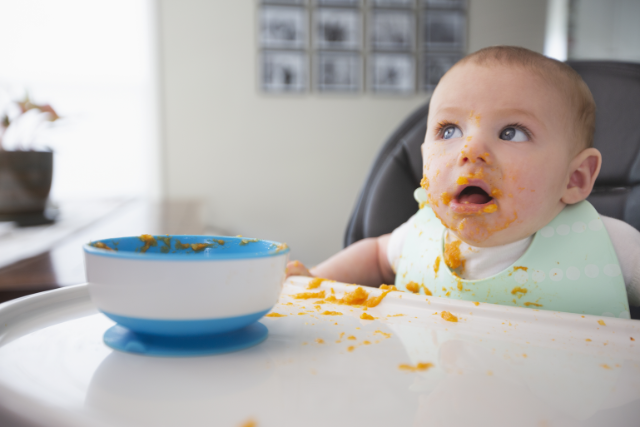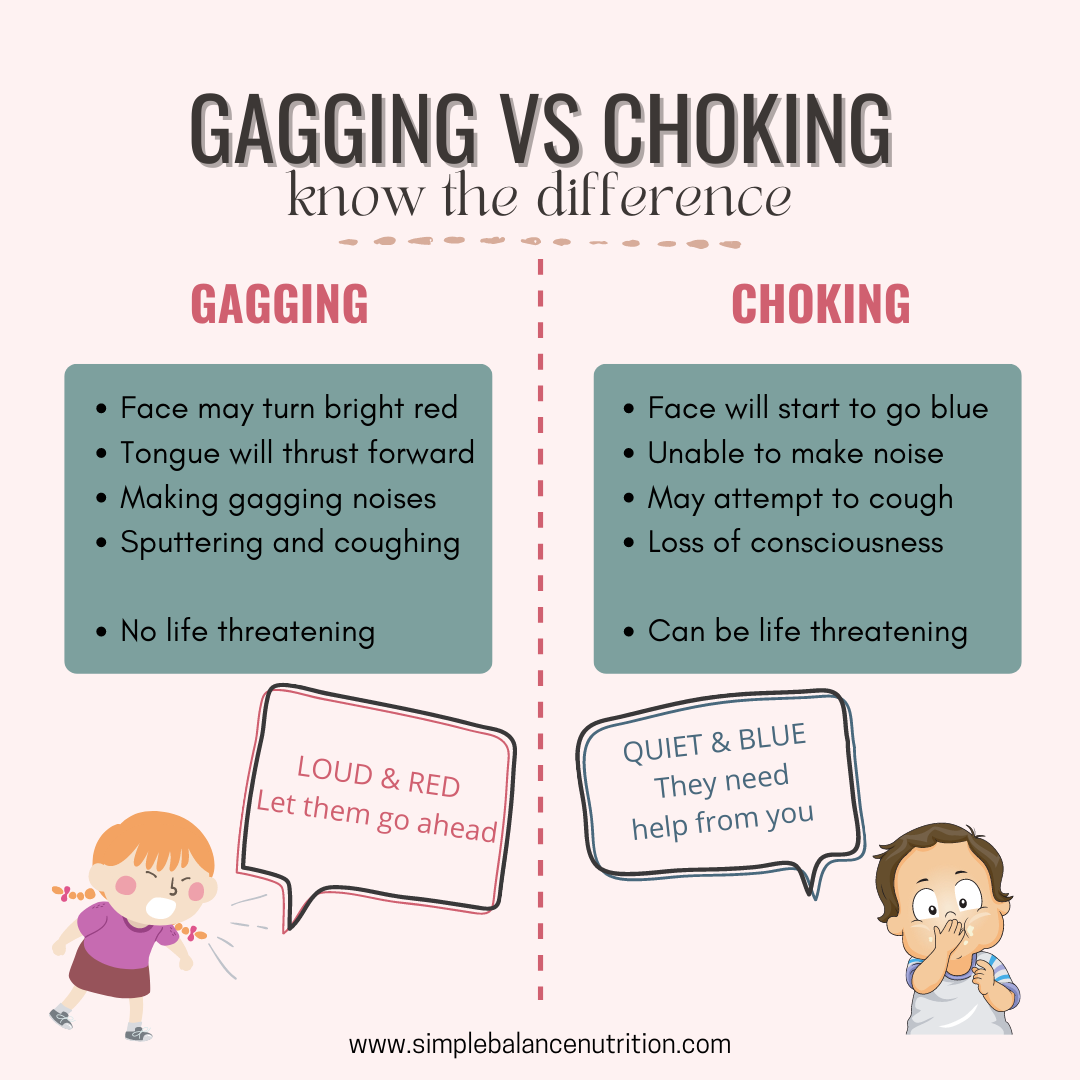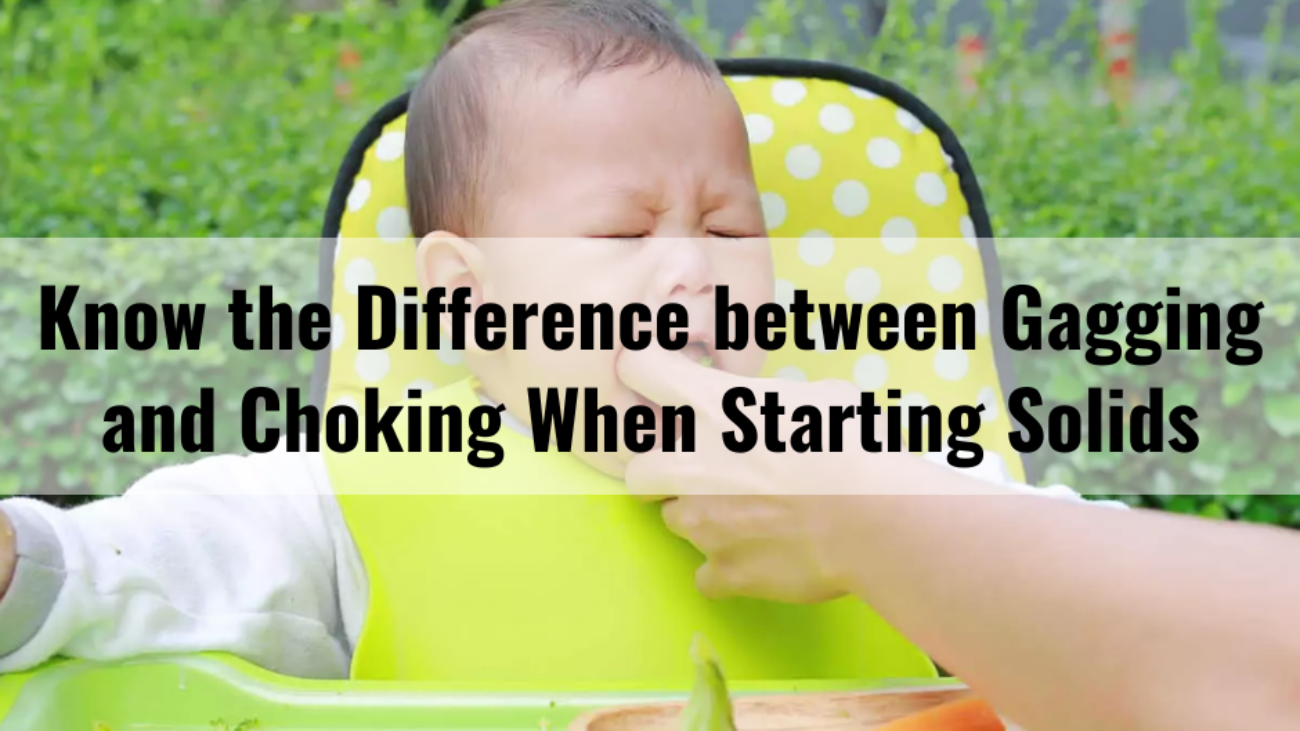Many parents are terrified of feeding their baby beyond purees or finger foods.
“Is there a risk of my baby choking if I introduce finger food?”
“What is the difference between gagging and choking?”
“How to prevent my child from choking?”
“What should I do if my baby starts choking or gagging?”
“How can I overcome my intense fear of choking when feeding my baby?”
DOES BLW INCREASE THE RISK OF CHOKING? (WHAT THE RESEARCH SAY)
A 2021 review study quoted: “Fear of choking was an important factor in parents’ decision not to implement BLW; however, this fear was not supported by the literature.”
Today, I will provide a breakdown of two studies that have examined the risk of choking associated with Baby Led Weaning as a method for introducing solids.
THE BLISS STUDY
BLISS stands for “Baby-Led Introduction to Starting Solids”. This clinical trial on choking was published in the “Pediatrics” journal and titled “A Baby-led Approach to Eating Solids and Risk of Choking” This study included 206 families.
During the study, parents completed questionnaires at 6, 7, 8, 9, and 12 months of age regarding their baby’s choking and gagging experiences. Additional follow-up questions were asked to parents who reported incidents of choking to gather information about the type of food consumed and how the choking was resolved.
The findings revealed that approximately 35% of babies experienced at least one episode of choking between the ages of 6 and 8 months. There was no significant difference in the incidence of choking between the two groups at any of the assessed time periods.
However, it was observed that babies who started with Baby Led Weaning initially experienced more frequent gagging at 6 months, which decreased by the time they reached 8 months. On the other hand, babies in the puree group exhibited an increase in gagging incidents by 8 months, likely due to their progression to consuming finger foods. It is important to note that the gagging stage is a normal part of learning to eat and cannot be entirely avoided.
Regarding cases where medical assistance was required due to choking, two babies choked on milk, while one choked on food that was placed in their mouth by a caregiver (it is not recommended with Baby Led Weaning). This highlights the fact that choking can occur with any type of food or substance.
Furthermore, the researchers discovered that both groups frequently offered choking hazards to their babies, and not all parents closely supervised their babies during feeding.
ANOTHER STUDY PUBLISHED BY Dr. Amy Brown
This observational study was titled “No difference in self-reported frequency of choking between infants introduced to solid foods using a baby-led weaning or traditional spoon-feeding approach. “
The survey also inquired about instances of choking experienced by the babies, including the frequency and the type of food involved (smooth puree, lumpy puree, or finger food).
The results indicated that 13.6% of the babies (155 out of the 1151) had experienced choking incidents. However, no significant correlation was found between the chosen method of introduction (BLW or traditional) or the frequency of spoon-feeding purees and the occurrence of choking.
It is noteworthy that among the babies who experienced choking, those following a traditional weaning approach had a higher number of choking episodes associated with finger foods and lumpy purees compared to babies following either strict or loose BLW.
This observation raises potential hypotheses: BLW mothers might exhibit lower anxiety levels, leading to less overinterpretation of choking incidents or excessive assistance during feeding, which can pose risks. Alternatively, the higher incidents of choking among traditional weaning babies could be attributed to their lower exposure to finger foods in the early stages, resulting in less practice when the gag reflex is more sensitive. This finding emphasizes the importance of introducing finger foods from the beginning, regardless of whether purees are included in the feeding approach.
Overall, based on the research, it suggests that the potential risk associated with BLW is not significantly higher compared to a traditional approach when initiating solid foods.
IS MIXED FEEDING SAFE?
Both Health Canada and the National Health Services (NHS) in the UK actually recommend a combination approach when introducing solids, which includes offering both finger foods and purees right from the start.
Despite some adamant claims made by Baby-led Weaning Facebook groups suggesting that this method increases the risk of choking, both research findings and personal experiences from my clients and my own child have not supported this belief.
Therefore, if you choose to incorporate both pureed foods and finger foods into your baby’s diet, there is no need to strictly adhere to the label of “Baby-led Weaning.” The important thing is to follow responsive feeding practices when spoon-feeding purees, being attentive to your baby’s hunger and fullness cues to avoid overfeeding. Additionally, make sure to offer finger foods during each meal to provide opportunities for your baby to practice self-feeding.
Ultimately, what matters most is following a feeding approach that suits your baby’s needs and abilities, regardless of the specific labels or guidelines, while prioritizing their safety and nutritional needs.
GAGGING

WHAT IS GAGGING?
Gagging is a natural reflex that helps prevent choking by stopping us from swallowing. It’s a normal and important part of learning to eat solid foods for babies. Gagging brings the food up to chew more before it goes back down, ensuring that only well-chewed food reaches the back of the throat to be swallowed.
Gag reflex effectively keeps larger food pieces near the front of the mouth, only allowing very well-chewed foods to the back to be swallowed.
During the initial stages of introducing solid foods, your baby’s gag reflex is positioned at the front one-third of their tongue. However, as they gain experience and exposure to different solid foods, the reflex gradually shifts further back. Eventually, it settles at the top of the throat, where the gag reflex is typically located in most adults.
WHAT TO DO IF YOUR BABY IS GAGGING
If your baby is gagging, avoid patting their back or attempting to stick your fingers in your baby’s mouth to remove the food, as this could cause the food to move deeper and potentially result in choking. Instead, demonstrate coughing the food up and spitting it out. Remember to stay calm and relaxed, as your reaction can influence your baby’s response to gagging and make the eating experience less enjoyable for them.
Never interfere! Allowing your baby to stay in control and figure it out on his own.
HOW TO PREVENT GAGGING
To help prevent gagging, there isn’t much you can do during your baby’s mealtime. However, you can start preparing them for learning how to eat by bringing them to the table around 5 months of age. Offer them a “hard munchable” item to chew on, such as a rib bone, celery, or a raw carrot. Although they won’t actually consume it, this will make your baby feel included in the family meal and increase their awareness of their mouth and how it functions. It can also strengthen their mouth muscles and potentially reduce a highly sensitive gag reflex.
WHEN TO GET HELP FOR GAGGING
If your baby continues to gag with every bite after a few weeks of introducing solid foods, it may be necessary to seek assistance from an Occupational Therapist or Speech-Language Pathologist.
Occasionally, babies may gag to the point of vomiting, which is also relatively common. To minimize this, try spacing out milk feedings from solids to ensure their stomach is not overly full during mealtime. This can reduce the likelihood of vomiting and prevent significant calorie loss.
If your baby consistently gags and vomits when eating solids exclusively, it might be beneficial to take a break from introducing solids for now. Your baby may not be quite ready, so waiting until they reach six months of age and then trying again could be a good approach.
For babies older than six months, consider offering purees for a week or two before reintroducing finger foods. While babies can still gag on purees, it might be easier for them to manage initially. Remember, it’s important to follow a baby-led approach if it aligns with your preferences and situation.
CHOKING
WHAT IS CHOKING?
Choking occurs when food accidentally enters the airway instead of the esophagus (food pipe).
During choking, a baby will not make much noise or may be completely silent as their air pipe becomes blocked. It is important to remember that loud gagging noises can be a positive sign in such situations.
When a baby is unable to obtain oxygen due to choking, their breathing is compromised, and their lips and face may turn blue.
IS CHOKING NORMAL FOR BABY LED WEANING
Fortunately, choking is significantly less common than gagging.
When reviewing the research, it is worth noting that approximately 13%-35% of babies in these studies were reported to have experienced choking at least once. Personally, I consider myself fortunate as I never had this experience with any of my children.
WHAT TO DO IF BABY CHOKES?
Choking is much more serious than gagging, and requires immediate intervention.
If there is another adult or older child present, quickly shout for their help and instruct them to call ambulance. In the absence of someone else, immediately make the call yourself while initiating infant CPR. Taking an infant first aid course can provide you with the knowledge and skills to handle such situations with confidence, even though the chances of it happening are unlikely.
KNOW THE DIFFERENCE BETWEEN CHOKING AND GAGGING

GAGGING
Loud and red = gagging, let baby work it out
- Face may turn bright red
- Tongue will thrust forward
- Making gagging noises
- Sputtering coughing
- No life threatening
It is advisable to avoid overreacting when your baby experiences gagging during mealtimes, as this may create fear and increase stress for both you and your baby. It is recommended to allow your baby a moment to handle the gag reflex independently without any intervention from you.
CHOKING
Silent and blue = choking, baby needs your help immediately
- Face will start to go blue
- Unable to make noise
- May attempt to cough
- Loss of consciousness
- Can be life threatening
Choking occurs when food passes beyond the gag reflex and obstructs your baby’s airway, leading to either partial or complete blockage. This can result in a significant reduction or complete cessation of oxygen reaching the lungs, making it difficult for your baby to breathe. Choking is a severe situation that demands IMMEDIATE intervention, and if your baby is choking, it is crucial to promptly initiate infant CPR.
CHOKING HAZARDS
It is important to note that BLW does carry a potential risk of choking compared to offering purees, especially when certain types of foods are introduced. Choking incidents occur when the airway becomes obstructed, which can happen if a baby bites off a piece of hard food that perfectly blocks the air passage. Therefore, careful attention must be given to the size and texture of foods offered during BLW. It is crucial to closely supervise your baby during mealtime and consider taking an infant CPR course as a precautionary measure.
HERE’S A FULL LIST OF POTENTIAL CHOKING HAZARDS

- Raw hard vegetables (carrots or beets)
- Raw leafy greens
- Fibrous and stringy foods (celery, pineapple, or asparagus)
- Firm fruit with and without peels (apples)

- Fruits with pits or seeds, that haven’t been removed (whole plum or peach)
- Whole grapes
- Whole blueberries
- Whole cherry tomatoes
- Dried fruits (raisins, dried apricots)
- Chunks of firm meat (steak)
- Fish with bones

- Whole hotdogs or sausages
- Cheese sticks

- Whole nuts and seeds
- Think globs of nut butter

- Hard candies, mints, or cough drops
- Gummy bears
- Popcorn
- Marshmallows
- Hard chips or nachos
- Chewing gum
- Snacks with toothpicks or skewers
ALTERNATIVE WAYS OF SERVING:
- Steam vegetables and fruit.
- Peel and grate hard vegetables and fruit like carrots, apples, and zucchini.
- Grate cheese.
- Always remove pits and seeds from fruit.
- Slice small and round foods into quarter lengthwise.
- Thinly spread any nut or seed butter on toast.
- Remove bones from fish or meat.
- Serve fresh, frozen, or canned (rinsed) corn instead of popcorn.
Well it’s possible for your baby to choke on food (or toys/coins/may other objects), there is a lot you can do to prevent choking.
TIPS TO PREVENT CHOKING WITH BLW

- Ensure that your baby is developmentally ready for solids.
- Positioning: Make sure your baby is sitting upright during mealtime and avoid a reclining position. Provide proper support by using a high chair that keeps your baby well-supported. Using rolled-up towels if needed to ensure proper positioning, with the tray (or table) positioned between their nipples and belly button.
- Minimize distractions: Avoid having toys or the TV on during meals as it may distract your baby and increase the risk of choking. Also, discourage running around with food once baby starts walking.
- Supervise mealtime: Always watch your baby while they eat and avoid sitting them on your lap during meals. It is important to have a clear view of your baby’s face while they are eating to ensure their safety.
- Let them self-feed: Never put a piece of food into your baby’s mouth. If you put food into their mouth, it may immediately fall to the back, without baby having a chance to control it with their tounge and chew it. Let them feed themselves. Also, never attempt to fish food out of their mouth.
- Offer safe size of food: Avoid round items like raw hard pieces of vegetables and fruit. Instead, either grate them or slice them thinly. Whole grapes, blueberries, or cherry tomatoes should also be sliced lengthwise into quarters, so they are not a round shape.
- Offer soft foods: Test the foods to make sure you can mash them with gentle pressure from your thumb and forefinger. This is called the “squish test“. If the food is harder, make sure it’s in a safe shape (ex: grated or sliced thinly)
- Take an infant CPR course.
BOTTOM LINE
It’s very important for parents to recognise the difference between gagging and choking and the different ways each scenario should be treated.
Remember that gagging is a normal reaction that weaning babies have as their gag reflex is triggered while learning to eat. Choking is when their airway gets blocked, and requires immediate first aid and medical attention.
Hope this was helpful. Please check out more about food textures, finger foods and choking on my IG highlights.
Did you know that we offer personalized nutrition counselling for kids and families? If this is something you’d like to learn more about, please visit here.


